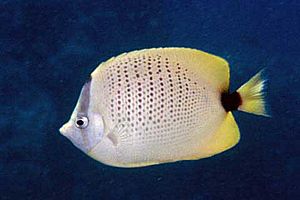Millet butterflyfish facts for kids
Quick facts for kids Millet butterflyfish |
|
|---|---|
 |
|
| Conservation status | |
| Scientific classification | |
| Genus: |
Chaetodon
|
| Species: |
miliaris
|
| Synonyms | |
|
|
The millet butterflyfish (Chaetodon miliaris) is a colorful fish that lives in the ocean. It belongs to the butterflyfish family. People also call it the lemon butterflyfish or the millet-seed butterflyfish.
This fish is special because it only lives around the Hawaiian Islands and the Johnston Atoll. It can be found in deep waters, sometimes as deep as 250 meters (about 820 feet). Even though it lives in a small area, there are many of them around Hawaii. Because of this, scientists say it is not in danger of disappearing.
Contents
How Scientists Group Animals
Scientists group animals to understand how they are related. The millet butterflyfish is part of a group called Exornator. It is probably related to other butterflyfish like the African butterflyfish and the crochet butterflyfish. The crochet butterflyfish might be its closest living relative.
What Does It Look Like?
The millet butterflyfish can grow up to 13 centimeters (about 5 inches) long. It has a flat body, like a pancake. Its back fin has 13 to 14 strong spines and 20 to 23 soft rays. The fin underneath has 2 to 3 spines and 17 to 20 soft rays.
This fish is usually whitish or yellow. It has many dark spots arranged in lines along its sides. A wide black stripe goes from above its eye to the edge of its gill cover. There is also a big black spot near its tail.
Where Does It Live?
This fish is found only in the Hawaiian Islands and the Johnston Atoll. It lives in waters as deep as 250 meters (about 820 feet). You can find it in different ocean homes. These include reefs along the coast, outer reefs, and calm lagoons.
Life and Habits
The millet butterflyfish is a social fish. It often swims in large groups, called schools, in the middle of the water.
What Does It Eat?
This fish mainly eats tiny creatures floating in the water, called zooplankton. It also eats small worms and other tiny animals it finds on the seabed. It sucks its food into its mouth very quickly.
Social Life and Reproduction
Millet butterflyfish do not seem to claim specific areas as their own. Instead, they gather in groups to feed at certain spots on the reef.
They usually breed between January and May. Young fish, called juveniles, can be found in the inner reef areas from April to June.
Millet Butterflyfish as Pets
Sometimes, people collect these butterflyfish from the wild to keep in aquariums. They are a good choice for a reef aquarium because they eat many different things. Other types of butterflyfish only eat specific corals, which makes them harder to care for.
Even though it is rare around Johnston Atoll, the millet butterflyfish is very common near the Hawaiian Islands. Scientists believe that collecting them for aquariums does not harm their overall numbers. Because of this, their conservation status is listed as "least concern", meaning they are not at risk.
See also
 In Spanish: Pez mariposa de Millet para niños
In Spanish: Pez mariposa de Millet para niños


